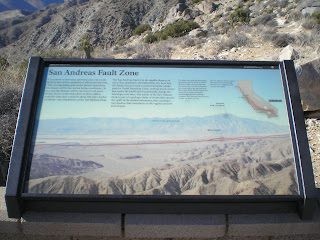Sagebrush RV Park*, Willcox, AZ

When is a tree not a tree? When it's a yucca.
Legend or rumor has it that the Mormons named the "trees" after the Bible's Joshua. The tallest tree in the park is just over 40'; hwr, it has no branches -- which means it never had blossoms. A winter freeze is believed to be necessary for the ends of branches to have blossoms in the spring; and then a yucca moth has to lay its eggs in the ovaries of one or more blossoms.

This Joshua Tree, seen in the late afternoon sun not too far from the Jumbo Rocks Campground, has had a more difficult existence than those in the photo above along the Keys View Rd.
Inicdentally, a Joshua tree is a member of the Agave family with a scientific name of Yucca brevifolia.

On the boundary. The western half of Joshua Tree NP is generally above 3000 ft. and part of the Mojave Desert; the eastern half is less than 3000 ft. and is Colorado Desert habitat.

Some monzogranitic rocks at the Ryan Ranch Trailhead Parking Area -- and a hint of things to come at the Jumbo Rocks Campground.

Another closer look to the left of the rocks in the above photo just before sunset.

A plaque explaining the Ryan Ranch, a homestead established before the turn of the 20th century. [Click once to enlarge; press ESC to return here.]

A shot of the namesake of the Jumbo Rocks Campground from just in front of Site #85 (of, if mem serves, 125 sites).

A "forest" of Joshua Trees along the Keys Veiw Road.

A look to the northwest from Keys View looking at snow on San Gorgonia Peak (11,500') north of the Coachella Valley.
Keys View is a must-see. But if your're driving a large RV or pulling an equally large 5th-Wheeler, you'll have to park and use your toad or tow vehicke, ride a bike six miles uphill, or, if you're really in shape, use "Shank's Mare."

Panning left, the snow-capped peak is Mt Jacinto (10,831') and the small ridge running down the Coachella Valley is the San Andreas Fault, which extends 500 miles to the north thru San Francisco, Tomales Bay, and then out to sea.

Panning left again, one can see reflections off of the buildings along the west side of the Coachella Valley from Palm Springs to Indio.

Panning yet farther left, one can see the upper end of the Salton Sea, which, along with Death Valley, contain two of the lowest spots in California; both are more than 200 ft below sea level. [Click once to enlarge; press ESC to return here.]

Another look to the south at the Salton Sea.

A plaque which identifies points of interest in the Coachella Valley. [Click once to enlarge; press ESC to return here.]

Another plaque -- this one on the San Andreas Fault.
An explanation of the Joshua Tree as a key habit for many birds, mammals, insects, and reptitles.

Panning to the upper left from the plaque, a "forest" of somehwhat "weather-beaten" Joshua Trees.

The Joshua Tree seeds which sprout are often those which were shelter by undergrowth which obscures them from feeding birds and animals.

Some rock formations with no Joshua Trees present.

A final cluster of granitic rocks.

Heading south toward Cottonwood Springs I came across the Cholla Cactus Garden. The Teddy-Bear Cholla are also called the Jumping Cholla "for their tendancy to attach themselves to the unwary."

A closeup of the "cuddly" teddy-bear cactus. I tried kicking a piece of cactus which was on the ground along my way back to my rig. And it "jumped" to the toe of my shoe. Several violent kicks failed to dislodge it. Finally, I knocked it off by kicking the corner of a rock.

A plaque explaining the ocotillo, a plant which does not depend on seasons but rather rain to sprout; in fact, it may sprout leaves and red blossoms as many as five times a year.

A closeup of an Ocotillo in the Ocotillo Patch along the Pinto Basin road to the southern entrance (Cottonwood Visitor Center) to Joshua Tree National Park.
--
* Sagebrush MH & RV Park: great shower & reasonable prices.
--
Links:
- Joshua Tree National Park pages on the U.S. Park Service website
- Wikipedia article on Joshua Tree Natl Park
- Wikipedia article on the San Andreas Fault
Su 20 Jan Actual Route: Wagon Wheel RV Pk - Las Cruces Walmart
M 21 Jan Actual Route: Las Cruces Walmart - Big Lots - Las Cruces Walmart
T 22 Jan Actual Route: Las Cruces Walmart - Dollar Tree - Library - Las Cruces Walmart
W 23 Jan Actual Route: Las Cruces Walmart - Library - Anthony - El Paso Alameda Ave Walmart
Th 24 Jan Actual Route: El Paso Alameda Ave Walmart - Socorro - Ysleta Br Lib - El Paso Alameda Ave Walmart
F 25 Jan Actual Route: El Paso Alameda Ave Walmart - Ysleta Br Lib - Horizon City Town Hall - Socorro - Ysleta Br Lib - El Paso Alameda Ave Walmart
Sa 26 Jan Actual Route: El Paso Alameda Ave Walmart - Ysleta Br Lib - El Paso Alameda Ave Walmart
Su 27 Jan Actual Route: El Paso Alameda Ave Walmart - Ysleta Br Lib - El Paso Alameda Ave Walmart
M 28 Jan Actual Route: El Paso Alameda Ave Walmart - Dollar Tree - Ysleta Br Lib - El Paso Alameda Ave Walmart
T 29 Jan Route: El Paso Alameda Ave Walmart - Ysleta Br Lib - El Paso Alameda Ave Walmart
--
Finding Campgrounds:
- RV Campgrounds from TrailerLifeDirectory.com
- Family Camping Directories from Woodalls.com
- Free campsites website
- Info on finding BLM Campgrounds





No comments:
Post a Comment